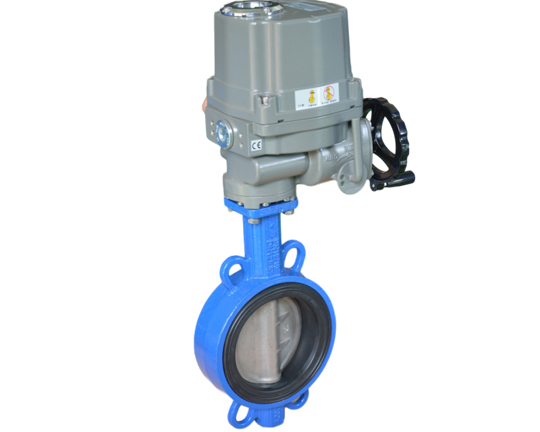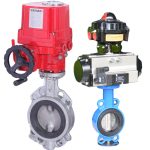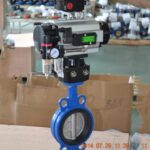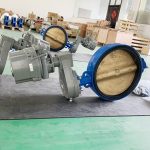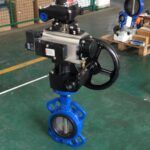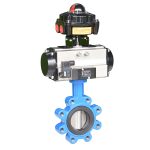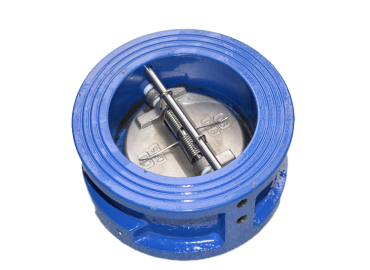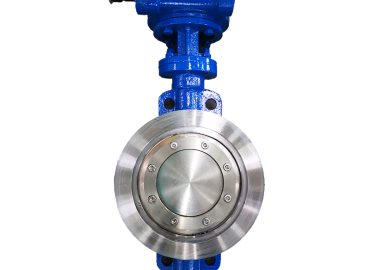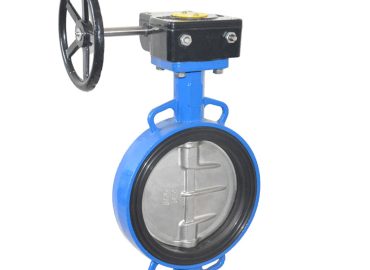Butterfly valves are an essential component in many industrial applications, such as HVAC, chemical processing, and water treatment systems. These valves regulate and control fluid flow, making them critical for operations to run efficiently and securely. There are two primary types of butterfly valves – manual and electric motorized valves. In this article, we will explore the key differences between electric motorized butterfly valves and manual valves. We’ll discuss the advantages and limitations of each type and help you determine which one to choose for your specific application.
Introduction
Electric butterfly valve differ from manual valves in various ways. The motorized butterfly valves are automated, allowing for remote control, and monitoring, which makes them more convenient and time-efficient, unlike the manual valves that require human intervention. The electric motorized butterfly valves also consume less energy, have smoother and precise control options, and require minimal maintenance, which is a significant advantage over manual valves. However, the manual valves are generally less expensive compared to electric motorized butterfly valves and may be better suited for applications with shorter lifespan requirements. Ultimately, the choice between the two types of valves will depend on specific application requirements and budget constraints.
Brief explanation of butterfly valves
A butterfly valve is a type of valve that is commonly used in industrial applications to regulate fluid flow. As the name suggests, these valves have a disc that acts as a butterfly that rotates to control the flow of liquid or gas. The disc is mounted on a spindle and positioned in the center of the pipe. When the valve is in the open position, the disc rotates a quarter turn to allow a full flow of fluid, and when it is closed, it closes off the flow completely. Butterfly valves are typically lightweight, compact, and easy to install, making them suitable for a wide range of industrial applications.
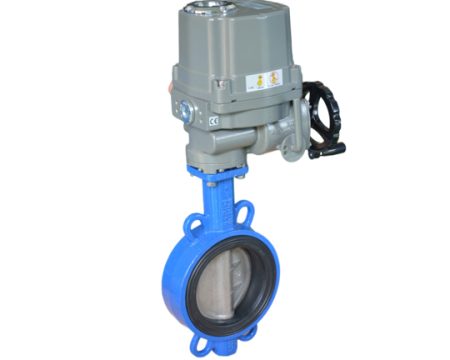
Significance of butterfly valves in various industries
Butterfly valves have significant importance across various industries, including HVAC, chemical processing, water treatment, and oil and gas, to name a few. These valves are vital for regulating and controlling fluid flow in pipelines and tanks, which is crucial to maintaining the efficiency and safety of the operations. For instance, in HVAC systems, butterfly valves play an essential role in controlling the flow of air to different zones, ensuring optimal temperature levels. In the chemical processing industry, butterfly valves are used to regulate the flow of chemicals, ensuring safe and efficient handling of fluids. In the water treatment and oil and gas industries, these valves perform similar functions and ensure optimal performance, reducing downtime, and increasing the lifespan of equipment.
Comparison of electric motorized and manual butterfly valves
Electric motorized butterfly valves and manual butterfly valves have several key differences. Manual valves are operated manually, requiring human intervention to control flow, while motorized valves are automated and allow for remote control and monitoring. Motorized butterfly valves offer significant advantages over manual valves as they consume less energy, have smoother and precise control options, and require minimal maintenance. However, manual valves are generally less expensive compared to electric motorized butterfly valves and may be better suited for applications with shorter lifespan requirements. Additionally, manual valves can be more straightforward to install and operate and remain a preferred option in certain industries. Ultimately, the choice between electric motorized and manual butterfly valves depend on specific application requirements and budget constraints.
Brief explanation of what the post aims to cover
This blog post aims to provide a comprehensive comparison between electric motorized butterfly valves and manual valves. The post will begin by introducing butterfly valves and their significance in various industries. It will then delve into the two primary types of butterfly valves, manual valves, and electric motorized butterfly valves, explaining their key differences, advantages, and limitations. The post will focus on aspects such as automation, energy efficiency, control options, maintenance requirements, cost comparison, and their respective applications. Finally, the post will help readers make informed decisions by summarizing the key differences, highlighting the factors to consider when deciding between electric motorized butterfly valves and manual valves, and providing recommendations.
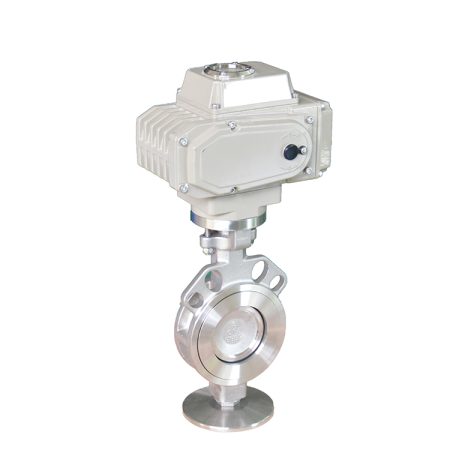
Manual Butterfly Valves:
Manual butterfly valves are a type of butterfly valve that is operated manually. These valves function by using a handle that rotates a disc, which controls the flow of fluid. Manual butterfly valves are widely used in various industries, primarily because they are simple to operate and maintain, and they offer reliable performance. Although they require human intervention, manual valves are a cost-effective option for applications with shorter lifespan requirements, as they are generally less expensive than electric motorized butterfly valves. Additionally, manual butterfly valves are a preferred option in certain industries where automation may not be suitable, such as in food and beverage applications, where hygiene considerations are critical.
Definition of manual butterfly valves
Manual butterfly valves refer to a type of butterfly valve that is operated manually, using a handle or lever. These valves consist of a circular disc that is mounted on a spindle in the center of a pipe. When the valve is open, the disc rotates a quarter turn to allow a full flow of fluid, and when it is closed, it closes off the flow completely. Manual butterfly valves are a simple and reliable method of regulating fluid flow in various industrial applications, including HVAC, chemical processing, and water treatment systems. These valves are relatively easy to install and operate and remain a popular option in industries where automation may not be necessary or appropriate.
How manual butterfly valves function
Manual butterfly valves function by using a handle or lever that rotates a circular disc, which regulates the fluid flow. The valve disc is positioned in the center of a pipe and is mounted on a spindle. When the valve is open, the disc rotates a quarter turn to allow fluid to flow freely, and when it is closed, the disc is turned to block the flow completely. This type of valve operates smoothly and is typically lower maintenance than other valve types. Because manual butterfly valves require human intervention to operate, they lack the efficiency and convenience of automated valves. Nevertheless, they remain a popular choice for many industries due to their simplicity, low cost, ease of maintenance, and reliability.
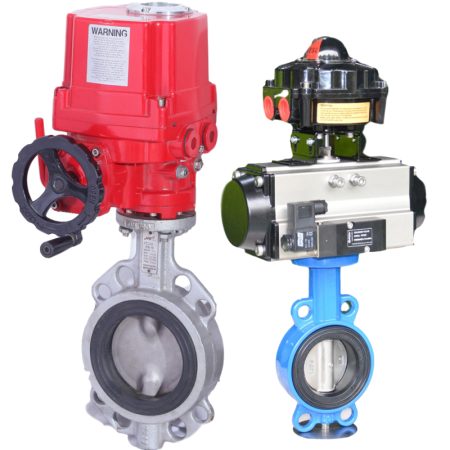
Advantages of using manual butterfly valves
Manual butterfly valves offer several advantages in industrial applications. These valves are relatively simple and easy to install and maintain, requiring little technical expertise. They provide reliable and efficient regulation of fluid flow. Since they are mechanically operated, manual butterfly valves are less prone to electrical or electronic malfunctions, making them ideal for use in certain environments. Additionally, manual butterfly valves are typically less expensive than automated valves, making them a cost-effective option for some applications. Finally, manual valves can be used to provide highly precise flow control, allowing users to make small adjustments to flow rates.
Disadvantages of using manual butterfly valves
Manual butterfly valves also have some disadvantages. Their operation depends on the presence of a human operator, which can lead to delays, potential mistakes, or even injury when handling hazardous materials. Furthermore, manual butterfly valves require direct access to the valve body, which can make them difficult to use in hard-to-reach or hazardous areas. They also require regular maintenance to ensure the effective operation of the valve. Manual butterfly valves may not be suitable for applications where frequent or sudden changes in flow or pressure are required since they require manual intervention to make adjustments. Finally, these valves may not be suitable for use in applications where automation or remote operation is necessary, or where highly precise flow regulation is required.
Electric Motorized Butterfly Valves:
Electric motorized butterfly valves are a type of butterfly valve that is automated, allowing for remote control and monitoring of fluid flow. These valves operate through an electric motor that opens and closes the valve disc, regulating fluid flow. Electric motorized butterfly valves offer several advantages over manual valves, including faster and more precise control options, low energy consumption, minimal maintenance requirements, and a longer lifespan. These features make electric motorized butterfly valves ideal for applications that require remote and automatic control of fluid flow. They can also be equipped with sensors that provide real-time monitoring of fluid flow rates and conditions, ensuring optimal performance and facilitating early detection of potential issues. While electric motorized butterfly valves can be more expensive than manual valves, their higher level of automation and efficiency makes them a sound investment for many industries.
Definition of electric motorized butterfly valves
Electric motorized butterfly valves are a type of butterfly valve that utilizes an electric motor to open and close the valve disc. These valves can be operated remotely, allowing for greater control and monitoring of fluid flow. Electric motorized butterfly valves are commonly used in industrial applications that require automatic or remote control of fluid flow, such as in wastewater treatment plants, chemical processing plants, and HVAC systems. They provide precise control of fluid flow rates, consumption of less energy than manual valves, and can be equipped with sensors that provide real-time monitoring of fluid flow conditions. Electric motorized butterfly valves offer several advantages over manual valves, making them a widely-used option in many industries.
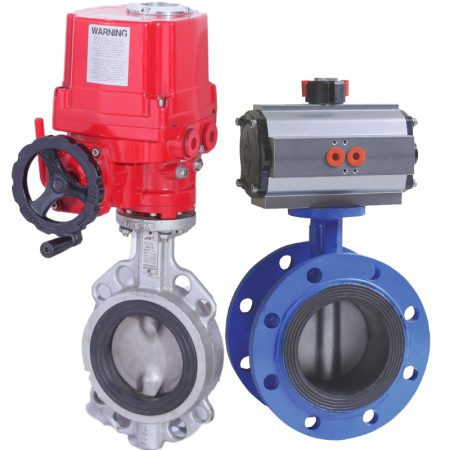
How electric motorized butterfly valves function
Electric motorized butterfly valves utilize an electric motor to control the opening and closing of the valve disc, allowing for precise and automated regulation of fluid flow. When the electric motor is activated, it rotates the valve disc a quarter turn, allowing fluid to flow freely when the valve is open. When the motor is shut off, the valve disc rotates back to its original position, stopping the flow of fluid when the valve is closed. Electric motorized butterfly valves can also be equipped with sensors that provide real-time monitoring of fluid flow conditions and can be programmed to adjust flow rates in response to changes in pressure or other operating parameters. This automation provides greater efficiency, accuracy, and convenience in controlling fluid flow rates, making electric motorized butterfly valves ideal for a wide range of industrial applications.
Advantages of using electric motorized butterfly valves
Electric motorized butterfly valves offer numerous advantages in industrial applications. These valves provide faster and smoother control of fluid flow than manual valves. They can be remotely operated and monitored, providing greater convenience and flexibility, as well as eliminating the need for direct human intervention. Moreover, electric motorized butterfly valves consume less energy than manual valves, reducing operating costs and emissions. They also have a long lifespan, requiring minimal maintenance and reducing maintenance costs. Electric motorized butterfly valves can be equipped with sensors and control systems that allow them to respond to changes in operating parameters, ensuring optimal performance and facilitating early detection of problems. Finally, these valves can provide highly precise flow control, making them ideal for applications that require high accuracy and consistency.
Disadvantages of using electric motorized butterfly valves
Electric motorized butterfly valves also have some disadvantages. These valves can be more expensive than manual valves, requiring a greater initial investment. Additionally, they require access to a power source, which may limit their use in certain remote or hazardous areas. Moreover, electric motorized butterfly valves can be more complex and prone to malfunctions than manual valves, requiring technical expertise for installation and repair. Finally, the sensors and electric control systems in electric motorized butterfly valves may require periodic calibration or maintenance to ensure accurate and reliable operation. Overall, while electric motorized butterfly valves offer significant advantages, their higher cost, complexity, and maintenance requirements may make them unsuitable for some industrial applications.
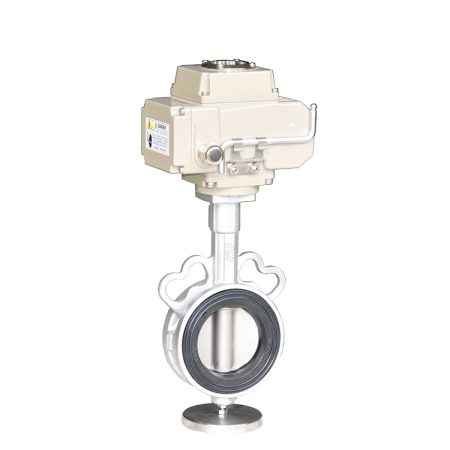
Comparison between Electric Motorized and Manual Butterfly Valves:
Electric motorized and manual butterfly valves offer distinct advantages and disadvantages. Manual butterfly valves are simpler and less costly than electric motorized valves, making them ideal for low-budget applications where frequent adjustments to fluid flow are not required. They are also easy to operate and work well in certain environments, such as hygienic food and beverage applications. Electric motorized butterfly valves, on the other hand, offer greater precision and automation in regulating fluid flow and can be controlled remotely, reducing the need for human intervention. They also consume less energy and have a longer lifespan than manual valves, making them a more cost-effective option over time. However, electric motorized valves are more complex and expensive to install and may require technical expertise to operate and maintain. Thus, the choice between electric motorized and manual butterfly valves depends on factors like the specific application, budget, desired level of automation, and maintenance requirements.
Price comparison of both valves
When it comes to price comparison between electric motorized and manual butterfly valves, manual valves tend to be significantly less expensive than electric valves. Manual butterfly valves require little automation and can operate effectively with a simple handle or lever mechanism, making them a cheaper option for certain applications. In contrast, electric motorized valves require more advanced technology, and automation capabilities, increasing their cost. Moreover, their installation and maintenance require technical expertise, leading to additional costs. While electric motorized butterfly valves can be more expensive upfront, their lower energy consumption, longer lifespan, and greater efficiency can make them a more cost-effective option over time, especially for industrial applications where automation and remote control are essential. Ultimately, the decision between manual and electric motorized butterfly valves depends on specific application requirements, budget, and maintenance considerations.
Comparison of performance between both valves
When comparing the performance of manual and electric motorized butterfly valves, electric valves tend to have better performance due to their automation and precision in regulating fluid flow. Electric motorized valves can be remotely controlled, reducing the need for human intervention, and their sensors and control systems allow for constant monitoring of fluid flow conditions. This enables the valve to respond quickly and accurately to changes in fluid flow or pressure, ensuring optimal performance and preventing damage or downtime. Manual valves require regular human intervention, which can lead to errors, delays, and potential injuries when handling hazardous materials. In terms of flow control, electric motorized butterfly valves are capable of more precise, fine-tuned adjustments than manual valves, making them a better option in applications where accuracy is paramount. Ultimately, while manual butterfly valves can provide reliable and straightforward fluid flow regulation, electric motorized butterfly valves offers more advanced performance features, making them better suited for certain industrial applications.
Comparison of safety features between both valves
When it comes to safety, electric motorized butterfly valves tend to offer better safety features than manual valves. Electric valves can be equipped with sensors that monitor fluid flow conditions and can detect anomalies, such as changes in temperature or pressure, to automatically shut down the valve if necessary. This eliminates the risk of over-pressurization or fluid leakage that can occur with manual valves. Moreover, electric motorized valves can be remotely operated, reducing the risk of injury from handling hazardous materials or working in high-risk environments. Manual butterfly valves, on the other hand, require direct human intervention, increasing the risk of errors, delays, or accidents. Additionally, manual valves may not be equipped with the advanced safety mechanisms that come with electric valves, such as automatic shut-off and alarm systems. Therefore, when it comes to safety, electric motorized butterfly valves may offer superior features, making them an ideal choice for applications that prioritize safety.
Comparison of maintenance requirements between both valves
In terms of maintenance requirements, electric motorized butterfly valves tend to have fewer maintenance requirements than manual valves. Manual valves often require routine maintenance to ensure they function optimally, and this can involve regular cleaning or repairs and the replacement of parts as needed. Conversely, electric motorized butterfly valves can operate autonomously, reducing the need for frequent maintenance. Additionally, the sensors and automated control systems in electric motorized butterfly valves can provide real-time data on fluid flow conditions, allowing for early detection and resolution of any maintenance issues that may arise. Manual valves may not have such advanced sensors and automation mechanisms. Ultimately, while manual valves are more straightforward in their use, they may require more maintenance. Electric motorized butterfly valves, therefore, require less routine maintenance, making them an ideal choice for applications that require minimal maintenance needs.
Conclusion
In conclusion, both manual and electric motorized butterfly valves have their pros and cons. Manual valves are simple, easy to install and operate, and less expensive than electric valves. However, they require regular human intervention and are less accurate and precise than electric motorized valves. They are suitable for basic applications that do not require automation or remote monitoring.
On the other hand, electric motorized butterfly valves offer numerous advantages over manual valves, especially in industrial applications. They provide precise, accurate, and remote regulation of fluid flow, reducing the need for human intervention and minimizing risks associated with handling hazardous materials. They also have sensors and control systems that can detect changes in fluid flow conditions, making them more efficient with less downtime. They have a longer lifespan and consume less energy, reducing operating costs in the long run.
Moreover, while electric motorized butterfly valves may be more expensive upfront, their cost-effectiveness over time, higher level of automation, efficiency, precision, and safety features make them a better option for industrial applications that require automation, precision, and safety.
In summary, the decision between electric motorized and manual butterfly valves depends on factors like budget, specific application requirements, desired level of automation, and maintenance considerations. While manual valves may suffice for basic applications, electric motorized butterfly valves provide advanced performance features that are superior for complex and demanding industrial applications.
Reiteration of the main points covered in the post
To reiterate, this blog post compared electric motorized and manual butterfly valves, analyzing their advantages and disadvantages in terms of performance, price, safety, and maintenance requirements. Manual valves were found to be cheaper but less precise, while electric motorized valves were more expensive but provided more automation and precision. Additionally, electric motorized valves were found to have better safety features and fewer maintenance requirements compared to manual valves. Ultimately, the best choice between these two types of valves depends on various factors such as application requirements, budget, and maintenance needs. However, electric motorized butterfly valves appear to offer superior performance features and safety benefits for demanding and complex industrial applications.
Summary of the key takeaways from post
To summarize, the key takeaways from this post are as follows: First, electric motorized butterfly valves offer more automation, precision, and safety features than manual valves, but at a higher cost. Second, manual valves are simpler, less expensive, and easier to install and operate, but they require frequent human intervention and lack advanced features. Third, electric motorized butterfly valves consume less energy, have a longer lifespan, and provide constant monitoring, reducing downtime for maintenance and repair. Finally, the decision between manual and electric motorized butterfly valves depends on various factors, including the specific application, budget, and maintenance considerations, but electric motorized butterflies appear to be a better option for those who need more precision, automation, and safety features.
Final thoughts on which valve may be best suited for different industries or applications.
In conclusion, the choice between electric motorized and manual butterfly valves ultimately depends on the specific requirements of the industry or application. For basic applications where precision and automation are not required, manual valves may be the best choice due to their simplicity, low cost, and ease of operation. However, for complex industrial processes that require automation, accuracy, remote monitoring, and safety, electric motorized butterfly valves are more suitable. These valves are designed to provide optimal performance, with features such as integrated sensors, advanced control systems, and high precision. Additionally, electric motorized butterfly valves are ideal for industries or applications that are energy-conscious, have environmental regulations, aim for high reliability, and benefit from minimizing downtime due to maintenance. Ultimately, it is important to consult with experts to identify the best valve for your industry/application based on your specific needs and budget.


